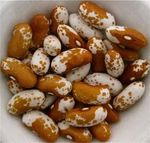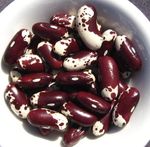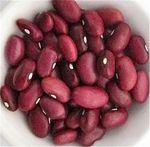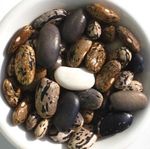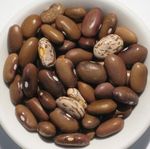Matt-Cyn Farms 2018 Bean Descriptions
←
→
Page content transcription
If your browser does not render page correctly, please read the page content below
Matt-Cyn Farms 2018 Bean Descriptions
Anna's Black-Eyed Pea
Black-eyed peas are sometimes called cowpeas, goat peas, purple-eyed peas,
frijoles or cream peas; this strain was given to us by our friend Anna. In the
southern U.S., eating black-eyed peas on New Year's Day is thought to bring
! prosperity in the new year. “Hoppin' John,” made of black-eyed peas, rice and
pork, is a traditional Southern dish. “Texas caviar,” another traditional dish, is
made from black-eyed peas marinated in vinaigrette-style dressing and chopped
garlic, and served cold. They make a great addition to stews, soups, curries and
salads and can also be mashed into a dip.
Black Coco
This fat round black bean has a thin skin, relatively firm but buttery consistency,
and a lot of flavor. These beans were brought from Latin America to France in
1928 and became a staple during WWII. They work quite well as a side dish with
simple seasonings.
!
Black Kabouli Garbanzo
Named for Kabul Afghanistan where this chickpea has been cultivated for
thousands of years. This unique black garbanzo has a flavor similar to the ones
you are used to but has a more creamy texture. It makes a wonderful dark humus
and is excellent for use in stews, Middle Eastern, or Indian dishes. They are high
! in protein, calcium, and iron.
Black Valentine
This is an old heirloom, kidney-type bean with a glossy black color and elongated
shape. Of the myriad variety of black beans, Valentine must be the best. It has a
meaty texture with rich, nutty flavor that makes the best black bean soup
ever! Also recommended for burritos, or mix with Coco Rubico beans for an
!
awesome chili.
Blue Marrow
Several years back a single plant from our Marrow Fat bean row produced a bean
with the most unusual deep blue color. We are 3 generations into stabilizing this
new blue bean which, in it's current form makes a colorful substitute for Marrow
Fat with large round blue, brown, and white beans.
Bronze Anasazi
Anasazi beans get their name from the people who grew them thousands of years
ago in the American Southwest. They are most commonly used in Latin, Mexican
and Southwest cuisine. This bronze color strain is unique to Matt-Cyn Farms. Try
them in refried beans, chilis and hearty stews with rich spices.
!
Butterscotch Calypso
An heirloom also known as the Steuben Yellow Eye or Molasses Face bean. They
date back to 1860's in New England and are used for "Boston Baked Beans".
Preferred for "Hoppin' John" in the South. This bean holds its shape when
cooked, yet has a very smooth texture; its flavor is similar to a baby red potato. A
! perfect bean for salads and baked dishes. Preparation: 1 cup uncooked yields
approximately 2 1/4 cups cooked.
© Matt-Cyn Farms 10/29/2018Cannellini
Also known as: White Kidney, haricots blancs, or Fazolia. They were originally
cultivated in South America; but they are usually associated with, and extremely
popular in, central Italy, Greece, and France. Although larger than the haricot
bean, their creamy smooth, but firm, texture and mild, nutty flavor makes them
! extremely versatile. Essential for many classic French and Italian dishes and are
the main ingredient in minestrone soups and cassoulettes. They need to be
cooked slowly to keep their shape.
Christmas Lima
A large, flat, maroon and white bean with swirls & speckles. Especially delicious
fresh with a buttery taste, but maintains an excellent rich flavor and quality when
canned, frozen or dried. This bean dates back to the 1840’s. It has a butter-like
texture and a subtle chestnut-like flavor.
!
Coco Rubico
This Italian Borlotto type bean hails from Tuscany. These beans have a natural,
slightly sweet taste. In Italy, Borlotti beans are used in pasta dishes and soups. A
member of the Cranberry bean family, add them to rice dishes, stews, casseroles,
cold bean and vegetable salads. For a quick and flavorful salad toss the beans
! with olive oil and some fresh-chopped rosemary.
Colorado Pueblo
A newly developed bean from Colorado with parentage from the Anasazi and Pinto
beans helps to make it a more successfully grown bean in the Willamette Valley.
They have a sweet taste and cook faster than other beans. Widely used in
traditional and southwestern recipes. An excellent soup bean but great too for
!
making refried beans, chili, or posole.
Garbanzo (or Bombay Chickpea)
“Bombay” chickpeas are a nice large type of garbanzo. These make an absolutely
lovely classic hummus. Also try using them for homemade falafel, seasoned with
Indian spices, garbanzo salad, chickpea stew, spiced dry roasted or even grind
some into chickpea flour.
!
Good Mother Stallard
A traditional family heirloom that has been enjoyed for generations. Dense and
delicious these beans expand to large meaty marbles when cooked; they retain
their beautiful markings and exude the most perfect pot liquor. A great dry bean
! with a wonderful rich, meaty flavor, great for soups.
Jacob’s Gold
The beans flavoring is fruity, rich and nutty, its consistency, dense and meaty.
Bears large, kidney shaped, speckled beans with a rich, full flavor. Wonderful for
both baked beans and chili. Jacob’s Cattle Gold Beans hold their shape when
! cooked for long periods of time and will soak up flavors and retain its shape after
cooking.
Kablanketi
This beautiful lavender colored bean is originally from Africa. The name Kablanketi
means “small child’s blanket” in Swahili. It holds its shape well when cooked and
has a meaty/chewy texture. The earthy flavor is excellent. These beans will work
! well in soups, salads, chilies, or lightly seasoned with rice.
Magenta
A bright magenta red bean that’s very smooth and creamy. It keeps it color nicely
when cooked. Makes wonderful red beans and rice or any other Southwestern
menu delight. This particular strain of red bean is unique to Matt-Cyn Farms.
!
© Matt-Cyn Farms 10/29/2018Marrow Fat
The Marrow bean is a large, round, white bean with a creamy/meaty texture, having
a hint of bacon flavoring; the name says it all. Sometimes known as White Egg
bean, this is the quintessential bean for ham and bean soup, or other thick, winter,
! comfort soups.
Mocha Mix
A pinto/southwest lineage strain that we isolated on Matt-Cyn Farms and have
saved seed to grow each year. It’s a delightful mix of colors and shapes to use for
refried beans, bean burritos, chili and soups.
!
Mocha
This bean is from the same parent as Mocha mix, but it is five generations towards
the development of an all uniform chocolate colored bean . . . the Mocha. This bean
will make a fine replacement for pinto or other southwest bean for buritos, refried
! beans, frijoles, or chili.
Mojave Playa
New for 2018. This beautifully colored mix is a cross between Amethyst and Pinto
unique to Matt-Cyn Farms; with blues, purples, creams, and speckles you won't
want to cook them, until you do. Try these for simple, lightly seasoned pot beans.
Mother's Marbles
This large round bean is a cross between Good Mother Stallard and Ojo de Cabra;
it has the most beatuiful color combinations including blacks, creams, reds, and
purples. Their dense meaty texture and flavor make them a favorite for stews,
soups, baked beans, and pot beans.
Ojo De Cabra (Goat’s Eye)
This large, round bean from north-central Chihuahua has an awesome flavor all on
its own just season lightly with salt, garlic, onions, and olive oil. Sweet with a
smooth texture that works well in hearty soups and stews.
!
Pawnee Shell
These beautiful brown spotted beans are reminiscent of a brown trout. They hold
their shape and keep their distinctive color when cooked; their texture is firm. The
Pawnee flavor is strongly nutty with a hint of butter and would make a uniquely
flavored bean salad, lightly seasoned bean dish, or fall soup.
!
Peruano / Mayacoba
Peruano beans are originally from South America and are commonly used in
Mexican cooking. They have a mild flavor and cook to a nice creamy texture, great
for refried beans.
!
Pinto
Popular as a refried bean in Mexican cooking, chilis and tacos. These dried beans
are beige with brown streaks, they turn a uniform brown when cooked, but keep
that great classic pinto taste. Pinto’s are in the kidney bean family and are an
excellent replacement for kidney beans in chili. 1 cup of dried pintos makes about
! 3 cups of cooked beans.
© Matt-Cyn Farms 10/29/2018Provence / Kablanketi
This beautiful lavender colored bean is originally from Africa. The name Kablanketi
means “small child’s blanket” in Swahili. It holds its shape well when cooked and
has a meaty/chewy texture. The earthy flavor is excellent. These beans will work
well in soups, salads, chilies, or lightly seasoned with rice.
!
Raven
A classic, versatile, essential black turtle bean. It holds its shape through lots of
cooking, yet retains its famous creamy interior. The bean broth can be used as a
base for all kinds of soups. Try this bean with rice or in salads, chili, refried beans,
! dips, soups, black bean and sweet potato stew, pot beans, black bean tacos and
Brazilian fejoida.
Red Hot Mamma
The Red Hot Mama is another child of the frisky Good Mother Stallard. These dark
red, round beans are the Matt-Cyn Farms answer to the famous True Red
! Cranberry bean and have become a favorite for our baked beans!
Rio Zape
Among our most beautiful beans with vibrant purple color streaked by black lines;
uniquely light in your hand. Also known as Hopi Purple. Cooks to a lovely purple.
Great for chili and other Southwest dishes. A very difficult bean to grow in the
! Willamette Valley as they are better adapted to the arid American Southwest, but
well worth it as they have a stand out flavor that can be enjoyed plain.
Snowcap
These large flat-oval beans have beautiful markings of tan and burgundy with a
cream-colored snow crest that retains color after cooking. These beans make a
perfect substitute for white kidney or cannellini beans. Tasting Notes: Similar flavor
! to a baked potato. Considered by many to be the creamiest and best flavored of all
beans. Great in creamy soups and chowders.
Tarbais
This large white bean is named for the Tarbais region in France where it is prized
for cassoulet. Cassoulet is a stew made with beans and multiple meats, usually
pork sausage and duck that makes a hearty one-dish meal. Tarbais has a thin skin
and a melt-in-your mouth texture and yet they hold up well in dishes like
!
cassoulets that cook for many hours. They are also well suited for salads, soups,
or any dish that calls for white beans.
Tarcabra
This amazing bean is a cross between Tarbais and Ojo de Cabra. It has the size
and shape if the Tarbais bean, but a color combination that will truely mesmerize
you. Falvor and texture are similar to Tarbais and can be used in similar dishes.
Trout
A close relative of Jacob's Cattle bean with crisp maroon and white markings. An
heirloom bean grown in New England since the colonial days. Originally from
Germany (Torellen). Wonderful sweet bean in soups and baked beans.
!
Vaquero
A really lovely cousin to the Anasazi bean, Vaquero have intriguing black and white
markings, not unlike an appaloosa horse might don. The flavor is somewhat like
the Anasazi but it's a little lighter. The real fun is the inky, black pot liquor. It looks
cool and tastes great. Suggestions: Pot beans, chili, stews
!
© Matt-Cyn Farms 10/29/2018Vermont Cranberry
Mottled cranberry-red and ivory markings. Excellent, nutty flavor and commonly
used in stews and soups. Firm texture stands up well for longer-cooking recipes.
Popular for Italian, Spanish and Portuguese dishes.
!
Whipple
Although its exact history is lost to time, this old family heirloom is named after a
pioneering family who settled in Oregon's Willamette Valley in the mid-19th century
and who raised this bean. Outside the local area, it has remained relatively
unknown. It has a very rich flavor. The beans are large and purplish-red with little
! white spots. A nice meaty bean that will work well in soups, salads or side dishes.
Yellow Indian Woman
The Native Americans in Montana grew this gold-colored bean and it has been
passed down through generations of families for us to enjoy today. A distant
cousin to the pinto family with a very flavorful taste. Well suited for most western
style recipes. Another bean that was served to the Lewis and Clark team on their
! famous voyage west.
Yin Yang
A true boutique bean with beautiful, dramatic black and white color patterns, also
called orca bean, or black calypso. Developed by growers in Europe. Enlarges 2x
when cooked. Smoothly textured with a mild vegetable-like flavor. Blends
wonderfully in salads and with its cousins Red Calypso and Butterscotch Calypso
! beans. Adds a visual flare to almost any recipe. Excellent in baked dishes, soups
and stuffings or makes a tasty cassoulet. Blends well with fresh corn.
Zolfino
Zolfino beans are small, round and light yellow in color, with a lighter eye. Despite
their thin skin, they tolerate long cooking times (three, four hours or more). When
cooked, they are dense and creamy, melting in the mouth like butter. They can be
eaten boiled, dressed with some extra virgin olive oil and laid on roasted Tuscan
! bread, or as a simple side dish to your favorite meal!
The description of varieties and their characteristics are as accurate as our experience in growing and eating them have shown us.
Nutritional Information
The new U.S. Department of Agriculture dietary guideline using the Eating Right Pyramid suggests, that the foods lowest in fats,
oils and sugars (fruits, vegetables, dry beans and grains) should make up the largest portion of our daily meals.
The benefits of using beans on a daily basis have recently been promoted because studies show beans help to reduce cholesterol
while providing excellent nutrition. When combined with nuts, seeds or grains, they form a complete high-fiber vegetable protein.
Most beans contain only 2-3% fat. Beans are the perfect food for a fat-restricted diet. You may never have to count calories again.
Beans contain no cholesterol, and they can help lower your cholesterol level because they are one of the richest sources of fiber!
Most beans contain at least 20% protein and are high in carbohydrates, which provides long-lasting energy.
In addition, beans provide essential B Vitamins and Iron.
Adding beans to your daily meals insures total nutrition; with the wide selection of beans you should be able to find the right flavor
for you.
Beans have been used throughout the earth for thousands of years. They come in hundreds of shapes sizes and colors, are
versatile and amazingly convenient because they can be dried and stored for years. Soaking beans for a couple of hours brings
them back to life, activating enzymes, proteins, minerals and vitamins.
Beans can be eaten raw, sprouted or cooked, ground into flour, curdled into tofu, fermented into Soya sauce, tempi and miso. They
are excellent in chilies, soups and salads.
Soaking beans: Very fresh beans do not require soaking before cooking, however, there are several advantages to soaking. First,
rehydrating the beans by soaking evens out the cooking time so that all your beans will be done at the same time. Second, soaking
improves the nutrition of your beans by neutralizing mineral-absorption-blocking phytic acid in beans, and releasing gas-causing
enzymes and tri-saccharides into the soaking water. Cover the beans with a few inches of water and soak for at least 8 hours or
overnight, then rinse and put into fresh water for cooking.
© Matt-Cyn Farms 10/29/2018You can also read





